|
While the guitar was not widely
recognised as real art, the instrument was tremendously popular with the
bourgeoisie for light distraction; divertissement. This called for music
teachers, so Søffren Degen ventured on as a guitar teacher first and a
guitarist second, even though his talent for playing the instrument is
described as having been quite out of the ordinary.
This didn't last long, however.
Quickly the tides turned and the piano forte became the instrument that
everybody turned to. In 1808 a very strict import tax had been imposed
on all finished goods, incl. musical instruments. The tax was value
added and given the relatively high build price of a piano, the Danish
piano builders were favoured tremendously. That combined with the newly
filed patent of C.C. Hornung for a cast iron frame which dramatically
reduced the price of a piano compared to those with wooden frames,
fueled a dramatic increase in pianos in Danish homes at the cost of
guitars. The consequences were that Degen's life took another rapid
plunge, now that the call for guitar teachers had all but disappeared. A
resolute man, however, Degen directed his passion towards photography
and opened the first daguerreotype studio in Copenhagen with his younger
half sister Thora Hallager.
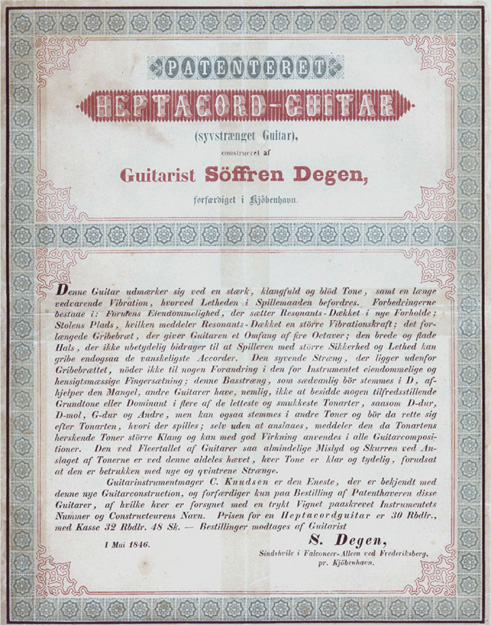
Advertisement
(The Danish Music Museum –
Musikhistorisk Museum & The Carl Claudius Collection) |
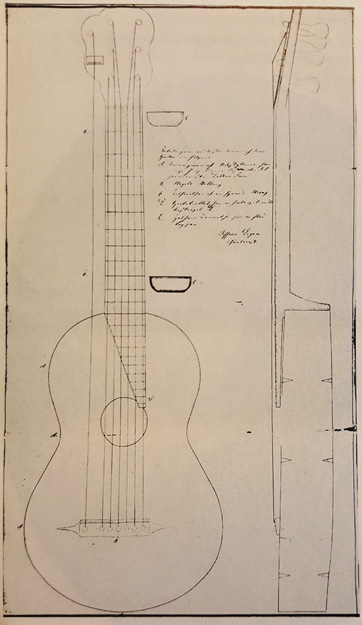
Drawing from the heptacord patent
(The Danish National Archives) |
Then – in 1845 Degen was
awarded a five year patent for his new heptacord guitar. Already known
for his precise and above all powerful articulation on the guitar, his
pursuit for a more complex sounding instrument is hardly surprising. He
even had the blessing of Napoleon
Coste before creating his version of the seven-string guitar. As
Erling Møldrup so astutely noted; perhaps he should have asked René
Lacôte instead – the man who had built Coste's heptacord and
received a prize for it only 6 years earlier. Exactly when Degen had met
Coste before the realisation of the heptacord is uncertain. They are
known to have become friends a couple of years later while Degen visited
Paris. The actual fabrication of the heptacord was left in the hands of
Danish luthier Carl Knudsen, who would show an instrument at the Danish
Industrial Association's exhibition in 1846. The instrument was
described like this in an advertisement:
“...the improvements
consist of: The peculiarity of the Shape that puts the resonating Board
in new Movement, the position of the Bridge that convey to the
resonating Top a greater Power of Vibration, the extended Fretboard that
gives the Guitar a Range of four Octaves, the wider and thinner Neck
that in no small Amount helps the Player to pursue even the most
difficult of Chords with greater Security and Ease”.
|
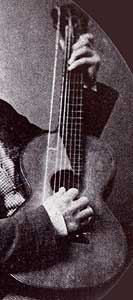
|
Danish
master luthier Kenneth Brögger mentions in his records of Carl
Knudsen's work that no heptacords from his hands are known to exist
today. The plans for Degen's heptacord do, however, exist at the Danish
National Archives as do an almost complete collection of sheet music,
including many hand written pieces from Napoleon Coste (The Rischel
& Birket-Smith Collection at The Danish Music Museum –
Musikhistorisk Museum). It is uncertain how Degen's heptacord differed
from Coste's Lacôte in design, if indeed it even did.
The same year Søffren Degen
received a scholarship from the king to study lutherie in Germany and
Austria, partly by recommendation by royal choir master Henrik Rung,
who's son Frederik
Rung, coincidentally also adorns the harp guitar annals. Degen left
with his pregnant fiancee and her friend. Rumour had it that Degen's
fiancee had become pregnant, not by Degen but by someone of such high
station that Degen was powerless to vindicate himself and ultimately
causing them to break up.
Degen found his way back to his
daguerreotype studio and received scholarships to study photography
abroad, one of them in France. This is when he is known to have met
Napoleon Coste and the two of them became lifelong friends and exchanged
sheet music until Coste's death. By then Degen had a considerable
collection of both printed and typed music, many of them bearing
dedications from Coste.
But as history has a way of
repeating itself, photographic studios soon popped up all over
Copenhagen while the guitar largely disappeared from public and once
more, Degen was to see his livelihood disappear. Degen was back at the
theaters. It is interesting to note that despite Degen and his sister
operating a photo studio, very few photographs exist of Søffren Degen,
at least outside private collections.
Degen died in 1885 alone in a
loft, largely forgotten in his day but every so often played on the
radio today on this his 200th birth year. A young friend of his in his
autumn years, Hans Kaarsberg, gave this description in his memoires:
|
|
“Even though Degen
owned a rather large but low and old House in Smallegade on
Frederiksberg, he himself lived in a oblong and utterly horrible
Loft. Even though he, when he did go out, was well groomed and
well dressed, almost persnickety to behold [...]. Degen cooked
himself, frying Plaice in the Window Sill on an old Kerosene
Stove. Clad in an ancient, long, grey Dressing Gown, he presided
in this rag tag World visibly content: »Here is Peace, here;
yes«.
…
Although Degen played
a masterful Violoncel, the Guitar was an remained his favourite
Instrument to his Death. This, in some Respects rather poor and
antiquated Instrument with its six to eight Strings, became in
his Hands a rich and wonderful one. He was the complete Guitar
Virtuoso. When he sat by the open Window in my Loft... ...fantasising
on my old eight stringed Staufer awaiting my coming home from
Lectures, the entire House was at its Feet. When I would cross
the Yard, his playing resounded with the Force of a Forte Piano
and by every Window, People stood listening. It was in Truth a
Marvel.
…
What I learned from
this Master was in particular the Stroke and the Fact that the
Guitar is not a sentimental plunking Instrument but played
rightly, harbours that most masculine Power, the most Soul
filled Character”.
After Kaarsberg had
married and settled in the country side as a physician, he went
to Copenhagen to invite Søffren Degen to stay with him for a
while, only to learn of his friend's recent death. Kaarsberg
himself would become a colourful feature in Danish medicine; a
regular globetrotter, philanthropist, author and motorcyclist
– and, of course, guitar player. |
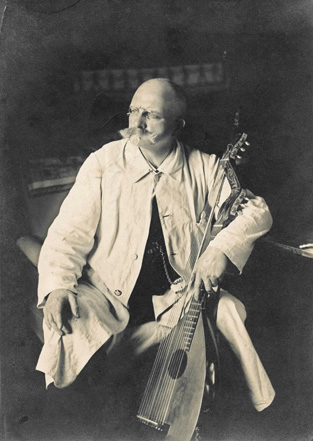
Hans Kaarsberg with guitar
lute
(Lokalhistorisk Arkiv Sorø)
|
The late Erling Møldrup, music scholar
and author of “Guitaren – et eksotisk instrument i den danske musik”
wherein Søffren Degen is well described, himself recorded Degen's
compositions. Exquisite examples of this can be found on the CD “Ricordanza”
with cello player Morten Zeuthen.
Another fine example of Degen on record, is Den Danske Degen Duo's
“Divertissement” where Kristian Buhl-Mortensen diverts with
Tove Dahl on recorder. Youtube has a few
examples of Degen compositions, one of which has Lars
Hedelius-Strikkertsen performing “Romanse.”
One could certainly hope that he and his Duo Suonante would consider
taking up Søffren Degen alongside their Henrik Rung compositions, with
their period correct attire and history lectures.
— Thomas Nielsen, Denmark,
January 2017
See
Gregg’s Blogg for more Danish harp guitar discoveries by Thomas
|
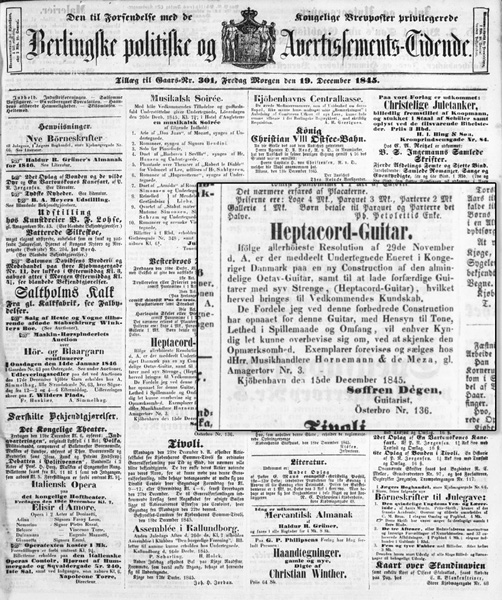
Heptacord advertisement in
Berlingske Tidende 19th December 1845
(The State and University Library under The Danish
Ministry of Culture)
|
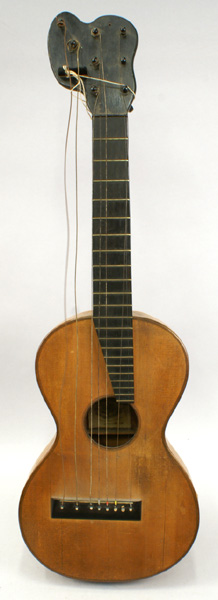
(The
Danish Music Museum – Musikhistorisk Museum &
The Carl Claudius Collection - photo: Kamilla Hjortkjær)
|
Søffren Degen's
Staufer?
by Gregg Miner
This eight-string Staufer, catalog #143 in
the Danish Music Museum, is said to have belonged to Søffren Degen.
In this case, the provenance comes from the gift letter in the
accession record: "Donated
by the son on behalf of the father. N. K. Madsen-Stensgaard,
who had been deceased for 20 years at the time of the
accession." So – certainly not
impossible, but likely never provable.
The label is that of a genuine J. Anton
Staufer (the son) from the 1831-1833 period. However, the
eight-string head and neck (and bridge, obviously) are later
replacements. Was it modified for Degen?
Degen's handwritten manuscript
demonstrates the use of the floating 7th string (low D) throughout, but only a single instance of a
low C (appearing in a short introduction, that could have been
re-tuned).
|
|
References / Books:
-
Kenneth Brögger: “Danske
guitarer - og deres byggere”, Forlaget Roset, 2001
-
Hans Kaarsberg: “Memoirer”,
Nordisk Forlag, 1921
-
Dorthe Falcon Møller:
“Det danske pianoforte frem til 1914”, Forlaget Falcon, 2004
-
Erling Møldrup: “Guitaren
- et eksotisk instrument i den danske musik”, Edition Kontrapunkt,
1997
-
“Dansk Biografisk
Leksikon”, 3. udgave, Forlaget Gyldendal 1984
References / Archives:
-
Det Kongelige Bibliotek:
Musiksamlingen, Rischel & Birket-Smiths samling af guitarnoder (www.kb.dk)
-
Det Kongelige Bibliotek:
Musik & Teaterafdelingen (www.kb.dk)
-
Lokalhistorisk Arkiv
Sorø (www.soroehistorie.dk)
-
Nationalmuseet:
Musikhistorisk Museum / The Danish Music Museum (www.natmus.dk/museerne/musikmuseet)
-
The Danish National
Archives (www.sa.dk)
-
The State and University
Library under The Danish Ministry of Culture (www.statsbiblioteket.dk)
Special Thanks to Marie
Martens, The Danish National Museum
|
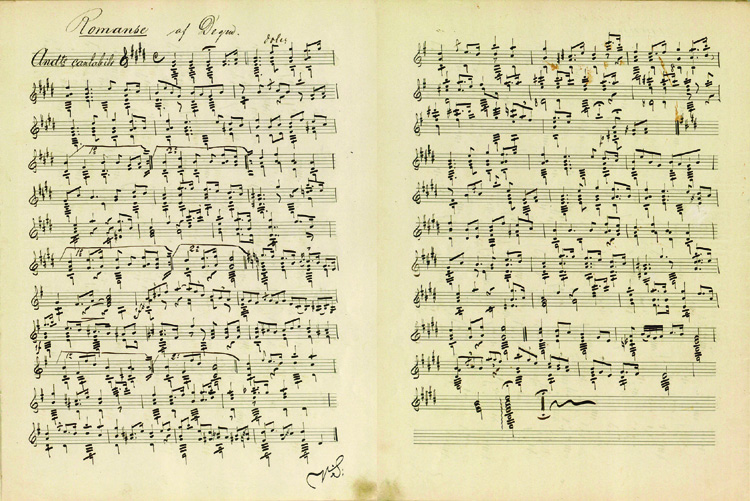
“Romanse” by Søffren Degen
in his own hand
(The Royal Danish Library /
The Rischel & Birket-Smiths Collection)
|
|
Links:
|
|
